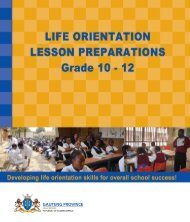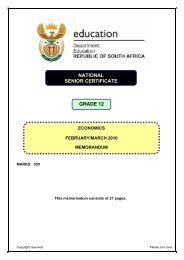Life Science Grade 11
Life Science Grade 11
Life Science Grade 11
Create successful ePaper yourself
Turn your PDF publications into a flip-book with our unique Google optimized e-Paper software.
<strong>Grade</strong> <strong>11</strong> <strong>Life</strong> <strong>Science</strong>s Lesson PlansGRADE <strong>11</strong> SUBJECT <strong>Life</strong> <strong>Science</strong>s WEEK 8 TOPIC Animal Diversity: surface area: volume Lesson 1LESSON SUMMARY FOR: DATE STARTED:LESSON OBJECTIVESDATE COMPLETED:Content: CAPS p41Calculate he approximate surface area to volume ratio of selected examples.The learner must be able to:• Calculate surface area to volume ratio for various objects that areTEACHER ACTIVITIES LEARNER ACTIVITIES TIMING RESOURCES NEEDED1.1 IntroductionGo through yesterday’s homework. Re-emphasize that in some organisms the surfacearea : volume ration is high and this often allows for efficient exchange of substancesacross the membrane, however where the ratio is smaller, i.e. the volume is greater,simple diffusion is not possible In today’s lesson we will work out the surface area andvolume of books arranged so that there is low and high volumes.Learners provide answers toyesterday’s homework.10 min2.2 Main Body (Lesson presentation)Revise the formulae for area and volume:Area = length X breadthTo determine surface area of a book for instance one would need to calculate all 6surfaces: top and bottom, front and back side, and the two lateral sides of the book.Add these together and you have calculated the surface area of the book.Formula for volume: length X breadth X heightLearners listen to the discussionon how to calculate surfacearea and volume.15 min<strong>Life</strong> <strong>Science</strong>s Practical Workshop 2Worksheet 54 Textbooks (all the same)rulerSubstitute values into the ratio to work out surface area: volume ratio.(Learners tend to struggle with working out the area of 6 sides of the book, as theyusually only want to work out 1 side, before learners do the practical activity, ensurethat they understand how to work out surface area.)Divide learners into small groups of about 4 learners per group where they are to workout the surface area: volume ratio of 8 books which are arranged flat on a worksurface. Learners are then to stack the books up and work out the surface area:volume.Working in groups learnerscalculate the surface area:volume of books arranged longways and ‘tall and fat’30 min2.3 Conclusion• Go through the answers that the learners obtained, and have the class decide whichanimal will use diffusion for gaseous exchange and which would require and internaltransport system.Learners provide answers to theircalculations5 minTerm 1 Page 68© Gauteng Department of Education (CAPS version)







